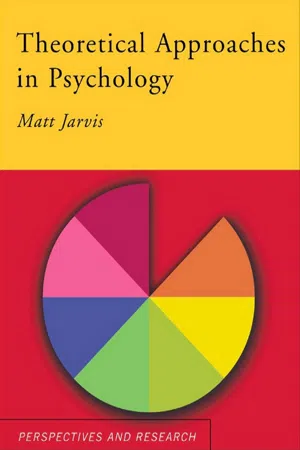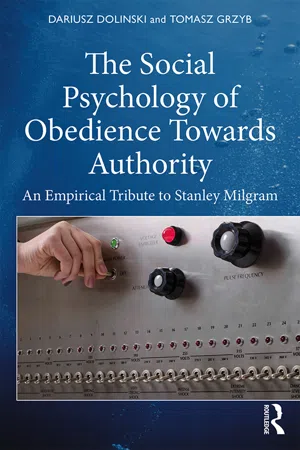Classic and Contemporary Research into Obedience
"Classic and Contemporary Research into Obedience" refers to the study of how individuals comply with authority figures. Classic research, such as Stanley Milgram's obedience experiments, demonstrated the powerful influence of authority on behavior. Contemporary research continues to explore factors influencing obedience, including social norms, situational variables, and individual differences. This body of research has contributed to our understanding of human behavior and social influence.
8 Key excerpts on "Classic and Contemporary Research into Obedience"
- eBook - ePub
- Alan Berkeley Thomas(Author)
- 2004(Publication Date)
- Routledge(Publisher)
...At worst they might be seen as public relations exercises which give the appearance of ethical propriety to research while actually ruling little or nothing out. More charitably, it is often the case that ethical problems in social research are complex and that there is no consensus among professionals about appropriate courses of action. If, as some philosophers have argued, right conduct cannot be guaranteed by following general moral rules but is situationally determined, it is no wonder that the professional associations’ ethics committees have so much difficulty in formulating clear-cut codes of practice for social and management research. A case study in research ethics: Milgram’s research on obedience to authority One of the best-known examples of social research to have given rise to ethical controversy is that carried out in the 1960s by the American psychologist Stanley Milgram at Yale University. His work has been variously described as ‘classic’, ‘famous’, ‘controversial’ and ‘notorious’ (Miller, 1986). Milgram conducted a series of experiments that were intended to illuminate the processes associated with obedience to authority. In part these studies were motivated by a desire to understand the kind of behaviour which resulted in the systematic extermination of millions of people in the Nazi death-camps during the Second World War. This activity required the obedience of ‘ordinary people’ to the murderous commands of their superiors. Milgram (1963, p. 371) described the project as follows: This article describes a procedure for the study of destructive obedience in the laboratory. It consists of ordering a naïve S[ubject] to administer increasingly severe punishment to a victim in the context of a learning experiment. Punishment is administered by means of a shock generator with 30 graded switches ranging from Slight Shock to Danger: Severe Shock. The victim is a confederate of the E[xperimenter]...
- eBook - ePub
Stanley Milgram
Understanding Obedience and its Implications
- Peter Lunt(Author)
- 2009(Publication Date)
- Bloomsbury Academic(Publisher)
...At the same time, however, under the influence of authority individuals can perform acts that they would otherwise regard as wrong, immoral or evil. This is an important starting point because it suggests that obedience as a basic function of complex societies can be used for both positive and negative ends, and is therefore value neutral. Although Milgram is interested in sociological and political questions, he places the individual at the centre of his enquiry. When an authority figure asks an individual to do something they disagree with there is a conflict between the individual and society. Milgram sees obedience to authority through the eyes of a social psychologist who is concerned with the relationship between individuals and society. For Milgram, the dilemma of obedience resists theoretical explanation and instead requires the disinterested view of the scientist to explore how people deal with the moral dilemma presented by obedience in real social situations. If a person is to follow their conscience rather than obey orders then they will have to disobey authority. Milgram designed an experiment in which an authority ordered individuals to do something that they disagreed with in order to examine the circumstances in which they will accept or resist authority. He was convinced that obedience had positive as well as negative consequences and assumed that individuals would value it, so that choosing not to obey and resisting authority would come at a psychological cost. Milgram assumed that his participants, ordinary citizens living in post-war America had unexceptional private lives, bringing up families, holding down jobs, getting on with their neighbours or not. However, these individuals left the privacy of their homes to travel to an institutional setting so although Milgram sampled from a ‘normal’ population the participants showed up in their public rather than their private identities...
- eBook - ePub
- Matt Jarvis(Author)
- 2005(Publication Date)
- Routledge(Publisher)
...However, most people did not feel that they could stop when ordered to continue by Milgram. Discussion This dramatic study demonstrates the power of authority over our behaviour. What is particularly interesting is that participants were very upset by what they had to do, but saw no alternative except to obey. Several other universities replicated the study and found similar results. Milgram has been criticised for the ethics of this study because he deceived participants, caused them great distress and did not allow them to leave the study when they asked to. * He was in fact briefly suspended from the American Psychological Association for his conduct of this study, but after an enquiry he was reinstated and his research approved. Another criticism is that Milgram underestimated the importance of individual differences in obedience. Some people are much more likely to resist orders than others, and this important fact was neglected by Milgram. One question asked following the Milgram studies was whether women would have the same tendency to obey when it meant harming someone—remember that Milgram’s participants were male. Blass (1993) reviewed eight studies and noted that seven of them found identical rates of obedience for men and women. Other studies, including those carried out in real-life settings, have confirmed that people have a remarkable tendency to obey those in authority. Bushman (1988) performed an experiment in a real-life setting where a female researcher, dressed either in a police-type uniform, as a business executive or as a beggar told people in the street to give change to a male researcher for a parking meter. Seventy-two per cent of people obeyed when she was dressed in uniform. As expected, fewer people obeyed in the other conditions. Interestingly, being dressed as a business executive or a beggar made very little difference—rates were 48 and 52 per cent respectively...
- eBook - ePub
Understanding Willing Participants, Volume 1
Milgram's Obedience Experiments and the Holocaust
- Nestar Russell(Author)
- 2018(Publication Date)
- Palgrave Macmillan(Publisher)
...Studying feignable behavior. Representative Research in Social Psychology, 7, 89–104. Mixon, D. (1989). Obedience and civilization: Authorized crime and the normality of evil. London: Pluto Press. Mook, D. G. (1983). In defense of external invalidity. American Psychologist, 38 (4), 379–387. Morelli, M. F. (1983). Milgram’s dilemma of obedience. Metaphilosophy, 14 (3–4), 183–189. Orne, M. T. (1962). On the social psychology of the psychology experiment: With particular reference to demand characteristics and their implications. American Psychologist, 17 (11), 776–783. Orne, M. T., & Holland, C. C. (1968). On the ecological validity of laboratory deceptions. International Journal of Psychiatry, 6 (4), 282–293. PubMed Parker, I. (2000). Obedience. Granta: The Magazine of New Writing, 71, 99–125. Patten, S. C. (1977). Milgram’s shocking experiments. Philosophy, 52 (202), 425–440. Penner, L. A., Hawkins, H. L., Dertke, M. C., Spector, P., & Stone, A. (1973). Obedience as a function of experimenter competence. Memory and Cognition, 1 (3), 241–245. PubMed Perry, G. (2012). Beyond the shock machine: The untold story of the Milgram obedience experiments. Melbourne: Scribe. Perry, G. (2015). Seeing is believing: The role of the film obedience in shaping perceptions of Milgram’s obedience to authority experiments. Theory & Psychology, 25 (5), 622–638. Pigden, C. R., & Gillet, G. R. (1996). Milgram, method and morality. Journal of Applied Philosophy, 13 (3), 233–250. Reicher, S., & Haslam, S. A. (2011). After shock? Towards a social identity explanation of the Milgram ‘obedience’ studies. British Journal of Social Psychology, 50 (1), 163–169. PubMed Rosenbaum, M. (1983). Compliance. In M. Rosenbaum (Ed.), Compliant behavior: Beyond obedience to authority (pp. 25–49). New York: Human Sciences Press Inc. Rosenhan, D. (1969). Some origins of concern for others. In P. Mussen, J. Langer, & M. Covington (Eds.), Trends and issues in developmental psychology (pp. 134–153)...
- eBook - ePub
Psychology and Politics
A Social Identity Perspective
- Alexa Ispas(Author)
- 2012(Publication Date)
- Psychology Press(Publisher)
...Indeed, by not acknowledging this variability, the focus has generally been placed on the behaviour (obedience) rather than the process leading to this behaviour. The message from Milgram's studies therefore becomes easily misunderstood as suggesting that we as humans cannot prevent ourselves from obeying authority figures. Reicher and Haslam (2011) have provided empirical evidence of this. They report asking 100 high-school pupils who were studying psychology to write a few sentences on the key message they had drawn from Milgram's studies. The researchers found that 93 per cent of those who were able to accurately describe the study interpreted it along the lines of ‘people obey instructions of people in authority’ (p. 165). Over half of these high-school pupils added suggestions that obedience was unconditional, such as the example ‘even when this involves harming others’ (p. 165) reported by the researchers. The way in which the findings were presented in the Obedience film is largely responsible for the lack of acknowledgement of variability in the rate of obedience. The film only briefly discussed some of the other experimental conditions in the narration. It was mentioned, for example, that in one condition, 90 per cent of participants disobeyed. However, it was only the shocking film footage, focusing on the one condition that was filmed, that fired up the public's imagination (Millard, 2011). The fact that the Obedience footage has generally been taken as evidence in favour of Milgram's interpretation is also problematic. This is because the film was carefully art-directed and edited to make for compelling viewing, and put forward a particular narrative of obedience (Millard, 2011). Milgram himself termed it ‘laboratory drama’, and wrote that his aim was to combine elements of science and art. The fact that the film comes across as an unmediated documentary is due to Milgram's effort to present it as an authoritative piece of scientific research...
- eBook - ePub
- Diana Jackson-Dwyer, Craig Roberts(Authors)
- 2015(Publication Date)
- Psychology Press(Publisher)
...keeping order in institutions Key terms Here is a list of important terms that you should learn in your revision. Try to write definitions for these after reading the chapter, and check your answers in the glossary on pp. 129–135. Essential terms that you must know in order to properly understand the topic are marked with an asterisk. Anonymous Authoritarian personality Authority figure Collectivist Confederates Conformity Debriefing Defiance* Denial (or diffusion) of responsibility* Ecological validity Extraneous variables Individualistic Informed consent Laboratory experiment Obedience* Participants Protection of participants Right to withdraw Some important definitions • Obedience: When people behave in a certain way because they go along with the demands of an authority figure. • Defiance: When people want to resist the demands of authority and not do as they are told. • Denial (or diffusion) of responsibility: When people feel less answerable for their behaviour because there are other people around. Any “responsibility” is shared, so no individual feels responsible. The effect of authority and the power to punish This can be explained via the study of Milgram (see pp. 16 – 20 of Psychology for GCSE Level, 2nd Edition). Study: Milgram (1963) Aim: He wanted to test out “destructive obedience” in a laboratory. Method: Milgram advertised for participants. Forty participants were then used in the study. Each participant met a Mr Wallace (a confederate) thinking that he was also a participant in the study. However, it was always “fixed” that the participant was the teacher whilst Mr Wallace was the learner. After this, Mr Wallace was seen being strapped into an “electric chair” device in the next room. The participant then left to sit in front of the “shock generator” in the next room. He was told that he would read out a series of word pairs (e.g. blue box)...
- eBook - ePub
The Social Psychology of Obedience Towards Authority
An Empirical Tribute to Stanley Milgram
- Dariusz Dolinski, Tomasz Grzyb(Authors)
- 2020(Publication Date)
- Routledge(Publisher)
...Stanley Milgram, however, took a different approach. Rather than consider how to alter the procedure so that people in the control conditions would not carry out the instructions of the experimenter (in order to demonstrate that in the experimental conditions, under the influence of the group, they do so more often), he became fascinated by what he had observed. He decided in a flash that instead of conformity, he would begin exploring obedience towards people in positions of authority or higher in hierarchies (Meeus & Raaijmakers, 1995). For accuracy’s sake, it should be added that in numerous descriptions of Milgram’s experiments an entirely different origin story for them is given. It is said that Milgram wanted to examine the psychological mechanism underlying German Nazism and intended to study blind obedience of Germans towards the orders and instructions given by the authorities. He began with experiments in the USA and unexpectedly discovered that it was not at all necessary to travel to Germany in order to ascertain the phenomenon of universal obedience. Indeed, he was able to observe the shocking scale of it in America. In our view, these perspectives need not necessarily exclude each other. It could be assumed that shortly after abandoning the idea of studying conformity and initiating studies of obedience, Milgram realized that this was not only a cognitively important phenomenon, not only unexplored by psychologists, but also tightly interwoven with real processes of social life. A mere 15 years had elapsed since the end of the war, and Milgram was among those who had lost many close and distant relatives in the Holocaust...
- eBook - ePub
- Zygmunt Bauman(Author)
- 2013(Publication Date)
- Polity(Publisher)
...The suspicion that even the victims may lose a good deal of their humanity on the road to perdition, was banned – the tacit prohibition which stretched to the extremes of absurdity in the American television portrayal of the Holocaust. It was such academic tradition and this public opinion, both deeply entrenched, heavily fortified and mutually reinforcing, that Milgram’s research challenged. A particular disquiet and rage were caused by his hypothesis that cruelty is not committed by cruel individuals, but by ordinary men and women trying to acquit themselves well of their ordinary duties; and his findings, that while cruelty correlates but poorly with the personal characteristics of its perpetrators, it correlates very strongly indeed with the relationship of authority and subordination, with our normal, daily encountered, structure of power and obedience. ‘The person who, with inner conviction, loathes stealing, killing, and assault, may find himself performing these acts with relative ease when commanded by authority. Behaviour that is unthinkable in an individual who is acting on his own may be executed without hesitation when carried out under orders. 3 It may be true that some individuals are prompted into cruelty by their own, unforced, thoroughly personal inclinations...







